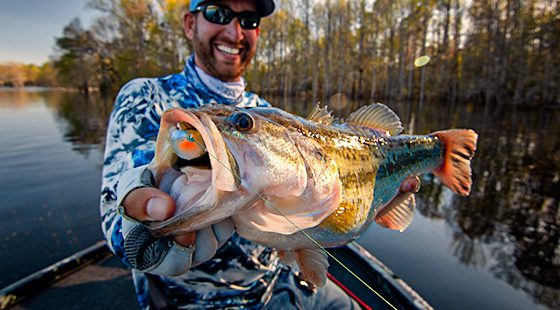While it’s no secret that Pool 8 of the Mississippi River is “a frog fisherman’s dream,” Rapala® Pro Ott DeFoe says, he was willing to share some of his secrets for where and when to throw what kind of frog to catch the most bass.
“I like a Popping Frog when I’m skipping that thing under overhanging trees, or I’m skipping really scattered vegetation – the kind of places where there are as many holes as there are matted stuff,” says DeFoe, the 2019 Bassmaster Classic Champion. “I like the Walking Frog or Walking Frog Jr. when those fish have seen a lot of frogs, when they’ve been pressured a lot, and in those situations where you are scooting it across those mats.”
DeFoe’s comments came last week after competing in the first two rounds of Major League Fishing’s Bass Pro Tour season-championship tournament, the Redcrest. He battled 30 of the world’s best bass anglers on Pool 8 of the Mississippi River, launching out of La Crosse, Wis. Pool 7 was the venue for Sunday’s championship round. As is the case in most tournaments on these waters, frogs were productive in many locations and conditions.
“Here on the Mississippi, Pool 7, Pool 8, there’s so much great stuff to throw a frog around,” DeFoe says. “When the water’s up – like it is a lot early in the season – you’ve got a lot of overhanging trees, a lot of cover like that. … When that water’s down, you’ve got so much matted vegetation, you’ve got a lot of duckweed.”
DeFoe worked closely with Terminator, a Rapala Respected Brand, to help design and engineer its Popping Frog, Walking Frog and Walking Frog Jr. Each frog features lifelike detail from nose to skirt. Designed to convert blow-ups into hook-ups, they all work as good as they look.
“A great frog needs more than a fancy paint job,” DeFoe explains. “It needs to walk right on every cast and its hooks and weight need to stay out of each others’ way.”
All three Terminator® frogs feature a custom VMC® frog hook, round-rubber legs and a heavy-duty welded line tie. Each is tail-weighted to increase casting distance and stability on the retrieve. The bodies of each are extra soft, easily compressing when bass bite them.
Another feature that sets apart Terminator frogs is an ability to shed water in between casts. A water-logged frog is hobbled by added weight and unbalanced action, throwing off its cadence and causing big bass to take a pass. But Terminator frogs eliminate this issue.
“Having as little water in your frog as possible on every cast is a big deal to keep the action right,” he explains. “So we engineered a neat little trick that clears out any water for every cast.”
Terminator frogs come in 16 color patterns: Hot Shad, Bluegill, White Camo, Black Camo, Cocoa Camo, Hot Mud Camo, Brown Camo, Yellow Leopard, Lime Leopard, Green Leopard, Hot Chartreuse Shad, Smoke Silver Shad, Bull Frog, Ghost Pearl, Ghost and Black Chartreuse Leopard.
Popping Frog Features
When conditions are right for froggin’, DeFoe throws a Popping Frog about 80 percent of the time. Featuring a cupped face, it pops and spits, causing a major commotion and drawing in fish. “I like the added action and sound it offers,” DeFoe says.
The Popping Frog walks well also. “Other frogs can maybe do one or the other well but not both,” DeFoe says.
By varying retrieve cadence and slack on the pause, DeFoe can make a Popping Frog attract fish in different ways. Retrieve it fast on a tight line to make it “chug really hard,” he instructs. Twitch it on a slack line to make it walk with an exaggerated side-to-side action. The “vast majority” of your strikes on a frog will come “in the first foot of your retrieve,” Defoe says.
The Terminator Popping Frog measures 2 1/2 inches. It weighs 9/16th an ounce.

Walking Frog & Walking Frog Jr.
When bass are seeking refuge from the sun under matted vegetation, DeFoe favors a Walking Frog or Walking Frog Jr.
“It’s totally weedless, so you can fish it across the surface of grass that’s totally topped out,” he explains. “Those are going to be places where you can’t really fish any other topwater kind of bait.”
On the Mississippi River pools in and around the La Crosse area, bass take cover under thin mats of duckweed in the summer. “That duckweed is just prime for those bass,” DeFoe says. “It’s thin, but it’s a perfect mat that creates a lot of shade. It’s a really good canopy.”
The pointed nose of a Walking Frog slides better over the top of a mat than a Popping Frog’s cupped face can.
“I don’t care if it’s duckweed, hydrilla, milfoil, grass, whatever it is – any type of vegetation that’s up on the surface, you’re going to be able to fish a Walking Frog in it, around it and through it, and not stay hung up,” DeFoe says.
Designed to maximize its hook’s efficiency, the Walking Frog’s trapezoidal-shaped weight is positioned where it doesn’t interfere with its hook at the moment of impact. “In a lot of frogs, the weight’s right in the way of the hook, right where the frog squishes down as a bass engulfs it,” DeFoe explains.
Measuring 3 inches long, the Terminator Walking Frogs weigh 11/16 oz. The Walking Frog Jr. is half an inch shorter and weighs ½ oz.



